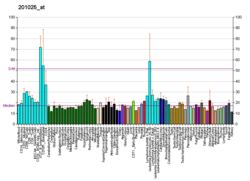From Wikipedia, the free encyclopedia
Protein-coding gene in the species Homo sapiens
Eukaryotic translation initiation factor 5B is a protein that in humans is encoded by the EIF5B gene .[ 5] [ 6] [ 7]
Accurate initiation of translation in eukaryotes is complex and requires many factors, some of which are composed of multiple subunits. The process is simpler in bacteria which have only three initiation factors (IF1, IF2, IF3). Two of these factors are conserved in eukaryotes: the homolog of IF1 is eIF1A and the homolog of IF2 is eIF5B. This gene encodes eIF5B. Factors eIF1A and eIF5B interact on the ribosome along with other initiation factors and GTP to position the initiation methionine tRNA on the start codon of the mRNA so that translation initiates accurately.[ 7]
^ a b c GRCh38: Ensembl release 89: ENSG00000158417 – Ensembl , May 2017^ a b c GRCm38: Ensembl release 89: ENSMUSG00000026083 – Ensembl , May 2017^ "Human PubMed Reference:" . National Center for Biotechnology Information, U.S. National Library of Medicine .^ "Mouse PubMed Reference:" . National Center for Biotechnology Information, U.S. National Library of Medicine .^ Lee JH, Choi SK, Roll-Mecak A, Burley SK, Dever TE (May 1999). "Universal conservation in translation initiation revealed by human and archaeal homologs of bacterial translation initiation factor IF2" . Proc Natl Acad Sci U S A . 96 (8): 4342–7. Bibcode :1999PNAS...96.4342L . doi :10.1073/pnas.96.8.4342 PMC 16334 PMID 10200264 . ^ Wilson SA, Sieiro-Vazquez C, Edwards NJ, Iourin O, Byles ED, Kotsopoulou E, Adamson CS, Kingsman SM, Kingsman AJ, Martin-Rendon E (Oct 1999). "Cloning and characterization of hIF2, a human homologue of bacterial translation initiation factor 2, and its interaction with HIV-1 matrix" . Biochem J . 342. ( Pt 1) (Pt 1): 97–103. doi :10.1042/bj3420097 . PMC 1220441 PMID 10432305 . ^ a b "Entrez Gene: EIF5B eukaryotic translation initiation factor 5B" .
Unbehaun A, Marintchev A, Lomakin IB, et al. (2007). "Position of eukaryotic initiation factor eIF5B on the 80S ribosome mapped by directed hydroxyl radical probing" . EMBO J . 26 (13): 3109–23. doi :10.1038/sj.emboj.7601751 . PMC 1914099 PMID 17568775 . Hayashi R, Ueda T, Farwell MA, Takeuchi N (2007). "Nuclear respiratory factor 2 activates transcription of human mitochondrial translation initiation factor 2 gene". Mitochondrion . 7 (3): 195–203. doi :10.1016/j.mito.2006.10.005 . PMID 17161026 . Olsen JV, Blagoev B, Gnad F, et al. (2006). "Global, in vivo, and site-specific phosphorylation dynamics in signaling networks" . Cell . 127 (3): 635–48. doi :10.1016/j.cell.2006.09.026 PMID 17081983 . S2CID 7827573 . Beausoleil SA, Villén J, Gerber SA, et al. (2006). "A probability-based approach for high-throughput protein phosphorylation analysis and site localization". Nat. Biotechnol . 24 (10): 1285–92. doi :10.1038/nbt1240 . PMID 16964243 . S2CID 14294292 . Rual JF, Venkatesan K, Hao T, et al. (2005). "Towards a proteome-scale map of the human protein-protein interaction network". Nature . 437 (7062): 1173–8. Bibcode :2005Natur.437.1173R . doi :10.1038/nature04209 . PMID 16189514 . S2CID 4427026 . Gevaert K, Staes A, Van Damme J, et al. (2006). "Global phosphoproteome analysis on human HepG2 hepatocytes using reversed-phase diagonal LC". Proteomics . 5 (14): 3589–99. doi :10.1002/pmic.200401217 . PMID 16097034 . S2CID 895879 . Beausoleil SA, Jedrychowski M, Schwartz D, et al. (2004). "Large-scale characterization of HeLa cell nuclear phosphoproteins" . Proc. Natl. Acad. Sci. U.S.A . 101 (33): 12130–5. Bibcode :2004PNAS..10112130B . doi :10.1073/pnas.0404720101 PMC 514446 PMID 15302935 . Ota T, Suzuki Y, Nishikawa T, et al. (2004). "Complete sequencing and characterization of 21,243 full-length human cDNAs" . Nat. Genet . 36 (1): 40–5. doi :10.1038/ng1285 PMID 14702039 . Marintchev A, Kolupaeva VG, Pestova TV, Wagner G (2003). "Mapping the binding interface between human eukaryotic initiation factors 1A and 5B: a new interaction between old partners" . Proc. Natl. Acad. Sci. U.S.A . 100 (4): 1535–40. Bibcode :2003PNAS..100.1535M . doi :10.1073/pnas.0437845100 PMC 149867 PMID 12569173 . Olsen DS, Savner EM, Mathew A, et al. (2003). "Domains of eIF1A that mediate binding to eIF2, eIF3 and eIF5B and promote ternary complex recruitment in vivo" . EMBO J . 22 (2): 193–204. doi :10.1093/emboj/cdg030 . PMC 140105 PMID 12514125 . Strausberg RL, Feingold EA, Grouse LH, et al. (2003). "Generation and initial analysis of more than 15,000 full-length human and mouse cDNA sequences" . Proc. Natl. Acad. Sci. U.S.A . 99 (26): 16899–903. Bibcode :2002PNAS...9916899M . doi :10.1073/pnas.242603899 PMC 139241 PMID 12477932 . Sørensen HP, Hedegaard J, Sperling-Petersen HU, Mortensen KK (2002). "Remarkable conservation of translation initiation factors: IF1/eIF1A and IF2/eIF5B are universally distributed phylogenetic markers". IUBMB Life . 51 (5): 321–7. doi :10.1080/152165401317190842 . PMID 11699879 . S2CID 45654480 . Nagase T, Ishikawa K, Suyama M, et al. (1999). "Prediction of the coding sequences of unidentified human genes. XI. The complete sequences of 100 new cDNA clones from brain which code for large proteins in vitro" . DNA Res . 5 (5): 277–86. doi :10.1093/dnares/5.5.277 PMID 9872452 .







